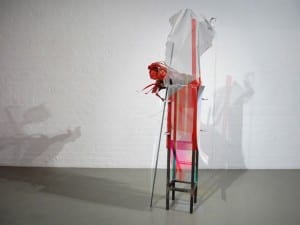Text by Angela Darby
Irish folk music has played an intrinsic part in the socio-political history of the Irish working-class. Through this medium an injured party could publicly express their frustrations at the hardship and ignominy of servitude placed on them by corrupt landlords or overseers. The folk song traditionally embodied a communal view; venting anger or giving a voice to hopes for a better future. Emotive ballads rallied the masses into believing that they could perhaps enact change.
For his solo exhibition at The Context Gallery, the artist Phil Hession presents three renditions of the Irish ballad The Rocks of Bawn. On an external wall at the entrance to the gallery the three versions, archived in old newspapers, are illuminated on large light-boxes. Within the darkened main gallery an array of machines, cameras and cables map out the space whilst a video silently and hauntingly illuminates one of the gallery walls. The footage projected was shot on the opening night as Hession performed each of the ballads live. The “raw” sound from this performance was recorded on three unique apparatus installed within the gallery space: a lathe attached to a record player, a polygraph and a set of single–lens reflex cameras. The artist activated each device and this symbiotic, physical relationship is present throughout the exhibition. At the first station a DJ’s record deck sits on top of a handmade, wooden structure. A lathe used in the cutting of master recordings is attached at the back and there is a crank handle at the side, which is reminiscent of an old-fashioned 78-rpm gramophone player. Spinning on the deck is a shiny compact disc with abrasions etched deep into its surface. As Hession sang he turned the handle scoring his vocal sound waves into the disc. The disc was then “played” and sampled to initiate a layering of live and recorded sounds. There is a paradox evident here in the concept of this piece: through the act of recording Hession has skilfully obliterated the contemporary technology by treating it as one would a vinyl record thus rendering it ironically obsolete. Finbar Rosato, contributing writer to the exhibition’s accompanying essay asserts that: “Hession strips the digital format of its anonymity …and gives it a new framework based on human experience and action.”
Attached to the floor of the gallery are a series of power cables that have been secured with black tape suggestive of a circuit board allowing the flow of power from one object to the other. At the second station a polygraph’s needles measured and recorded the performer’s physiological indices: respiration, pulse and blood pressure as he sang the next version of the ballad. The artist’s contact here is much more corporal as the relationship between man and machine moves beyond the purely instrumental. From the graphs still attached to the machine we can “read” Hession’s involuntary reflexes and visceral responses he produced at every vocal inclination of The Rocks of Bawn. At the third station, the artist sat in a chair facing a set of single-lens reflex cameras mounted on tri-pods. Hession captured his own self-portrait whilst performing the final rendition of the ballad. The flash photography created a dynamic theatrical strobe-like effect similar to the atmospheric lighting found in a club or music event.
Throughout the entirety of the performance Hession had been meticulously collating each piece of audio/visual material; even wiring the mechanical devices for sound: the creaking handle, the noise of the lathe machine, the needles on the polygraph, the shutters and flash from the SLR cameras have all been captured. Hessian and collaborator Christian Cherene have reassembled the resulting noises into short fragments of sound that softly emanate at each of the stations. With most performance art the viewer is usually met with the left behind debris and detritus but here Hession has cleverly and competently avoided this shortfall by presenting his “props” as fully formed, tangible works and sculptures that have a commanding presence of their own.
Aesthetica in Print
If you only read Aesthetica online, you’re missing out. The February/March issue of Aesthetica is out now and offers a diverse range of features from an examination of the diversity and complexity of art produced during the tumultuous decade of the 1980s in Art, Love & Politics in the 1980s, opening 11 February at MCA Chiacgo, a photographic presentation of the Irish Museum of Modern Art‘s latest opening, Conversations: Photography from the Bank of America Collection. Plus, we recount the story of British design in relation to a comprehensive exhibition opening this spring at the V&A.
If you would like to buy this issue, you can search for your nearest stockist here. Better yet call +44 (0) 1904 629 137 or visit the website to subscribe to Aesthetica for a year and save 20% on the printed magazine.
Phil Hession: My heart is always trembling, afraid I might give in, 17/02/2012 – 17/03/2012, The Context Gallery, 5-7 Artillery Street, Derry, BT48 6RG Derry/Londonderry. www.contextgallery.co.uk





